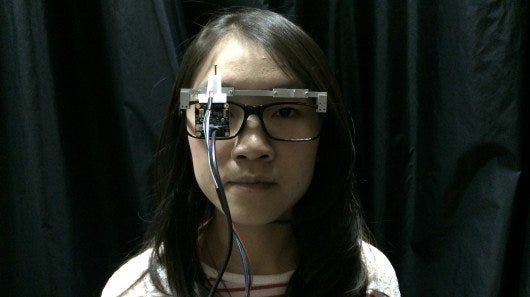August 4, 2014
Researchers in Taiwan have developed a wearable optical pupil-reading device prototype that may open the door to early detection of a common neurological condition found in those with diabetes, known as diabetic autonomic neuropathy.
The condition can be a serious complication for those suffering from both Type 1- and Type 2- diabetes that progressively affects the autonomic nerves controlling vital organs like the heart and gastrointestinal system. This condition often results in fainting, incontinence, nausea, heart arrhythmias, and an increased risk of bacterial infection.
|
A wearable pupillometer prototype can be mounted to a pair of glasses. |
Early detection for the condition has proven to be an arduous task, as doctors currently rely on observing changes in digestive speed, heart rate, and blood pressure to indicate the presence of diabetic autonomic neuropathy. To date, these observations can often be inconclusive, resulting in delayed detection and treatment of the condition. Early detection and treatment is vital as it can help limit the amount of nerve damage in patients, while preserving vital organ functions.
The pupil reading device, known as a pupillometer, is small enough to be mounted onto the front of a pair of eyeglasses, and measures 10 parameters related to pupil diameter and response time. Of those 10 parameters, researchers have found that five of them are significantly different in those suffering from diabetic autonomic neuropathy.
According to Mang Ou-Yang, who led the research at National Chiao-Tung University, the device measures pupil activity by emitting four colored lights into the pupil. A beam splitter attached to the device then filters the visible light that reflects from the eye to the device's camera to process the images for analysis.
"Compared to the existing diagnostic techniques," said Ou-Yang, "the pupillometer is a more reliable, effective, portable, and inexpensive solution for diagnosing diabetic autonomic neuropathy in its early stages."
According to the American Diabetes Association, studies have indicated that as many as 20% of individuals affected by Type 1 or Type 2 diabetes are suffering from symptoms of diabetic autonomic neuropathy. The pupillometer could prove groundbreaking in the detection of the condition, and Ou-Yang believes that if clinical trials are successful, the device could be available by the end of the decade.
The pupillometer is the latest optical device designed to detect diabetic complications, alongside the glucose-sensing contact lens project from Google and Novartis, an innovative smart lens designed to assist the monitoring of glucose levels in those suffering from diabetes. According to the International Diabetes Federation, diabetes currently affects over 300 million adults worldwide, and is expected to increase significantly over the next two decades. Continued research indicates that the eyes could be the new gateway for detecting, monitoring and managing this progressive and potentially fatal disease.
Refresh your medical device industry knowledge at MEDevice San Diego, September 10-11, 2014. |
Kristopher Sturgis is a contributor to Qmed and MPMN.
Like what you're reading? Subscribe to our daily e-newsletter.
About the Author(s)
You May Also Like



